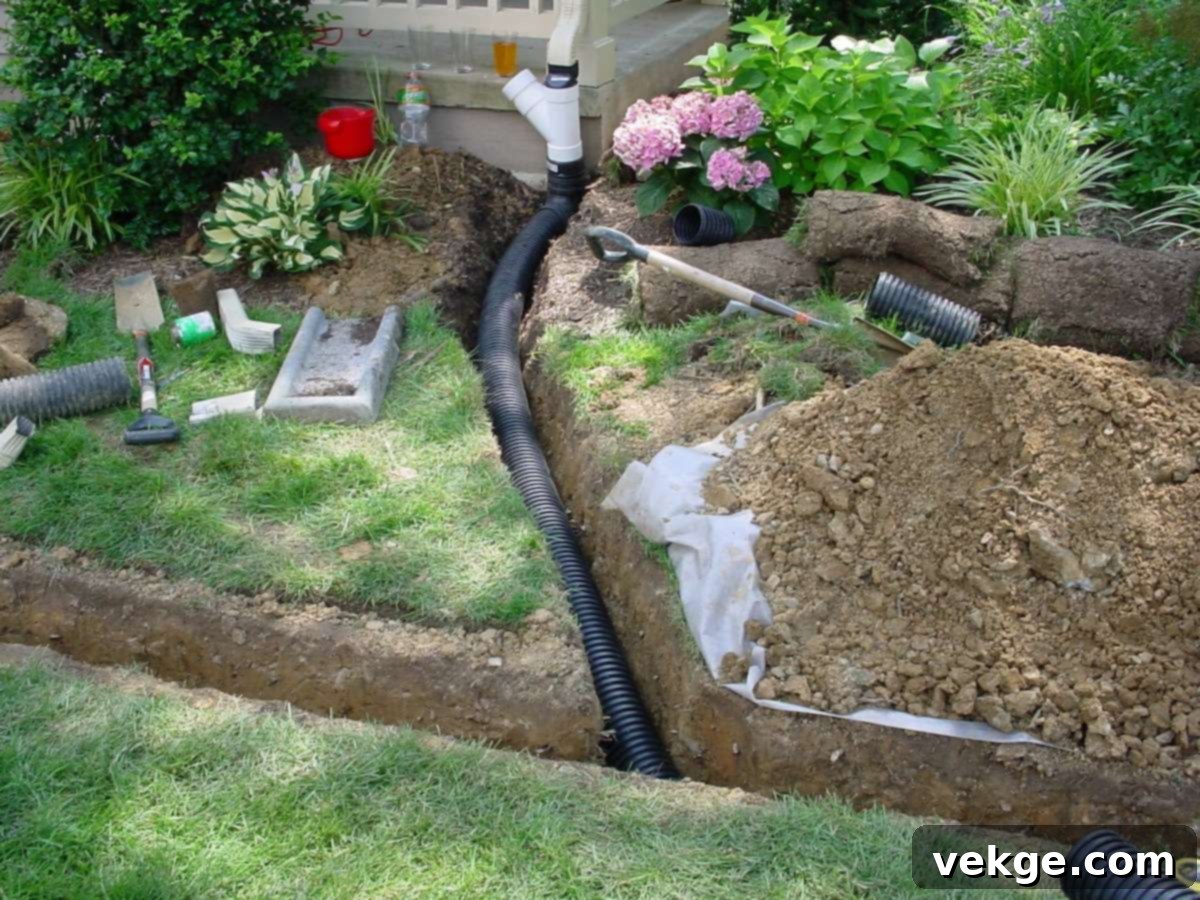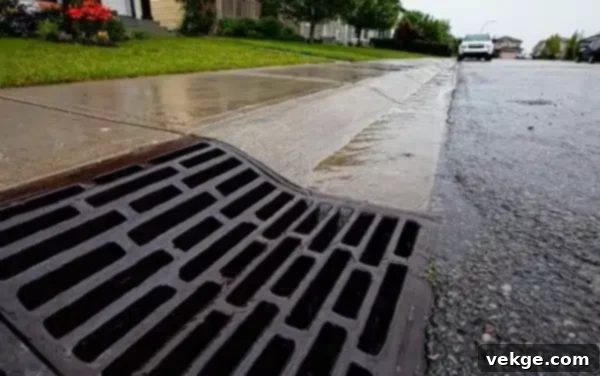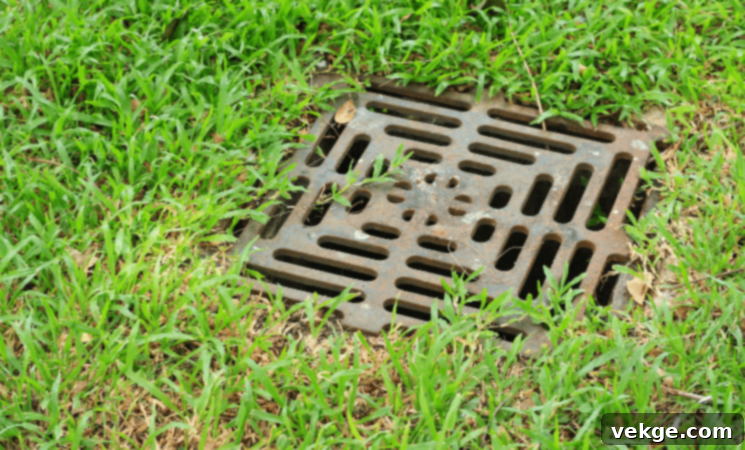Mastering Yard Drainage: Essential Solutions for a Dry and Healthy Home & Garden
Yard drainage issues are a pervasive concern for homeowners, manifesting in various forms from persistently wet lawns to severe structural damage affecting buildings. Ensuring proper yard drainage is not merely about aesthetics; it is absolutely crucial for maintaining the health and vitality of your lawn and garden, and critically, for safeguarding the structural integrity of your home’s foundation. This comprehensive article delves into the most common yard drainage problems, exploring their causes and consequences, and provides practical, effective solutions designed to help you achieve and maintain a dry, functional, and beautiful outdoor space.
Unpacking the Most Common Yard Drainage Problems
Understanding the specific issues that can arise from inadequate drainage is the first step toward effective remediation. When water doesn’t drain properly, it can lead to a cascade of problems that affect both your landscape and your home.

1. Persistent Standing Water and Soggy Lawns
Perhaps the most visible sign of poor drainage is standing water. Often accumulating in low-lying areas of the yard, standing water creates more than just an unsightly puddle. It transforms into an ideal breeding ground for harmful bacteria, mold, and unwelcome pests like mosquitoes. Beyond the nuisance of insects and potential health risks, standing water suffocates grass and other plants by depriving their roots of essential oxygen, leading to root rot, disease, and eventually, plant death. Prolonged sogginess can also compact soil, exacerbating future drainage problems and making your lawn soft, squishy, and unusable.
2. Destructive Soil Erosion and Nutrient Loss
Improper yard drainage can lead to significant soil erosion. When heavy rains cause water to flow rapidly over the surface instead of infiltrating the ground, it carries away valuable topsoil. This loss of nutrient-rich topsoil can drastically reduce the fertility of your garden beds and lawn, making it difficult for plants to thrive. Over time, severe erosion can create unsightly channels, expose plant roots, and even lead to the formation of sinkholes, destabilizing your landscape and potentially undermining pathways or patios.
3. Foundation Damage and Structural Compromises
One of the most concerning consequences of poor yard drainage is water damage to your home’s foundation and other building structures. When water repeatedly pools near your home’s foundation, it exerts immense hydrostatic pressure against the walls. Over time, this constant pressure can lead to cracks in the foundation, allowing water to seep into basements or crawl spaces. This moisture creates prime conditions for mold growth, which can cause significant health issues and further structural decay. Unresolved, this problem can escalate into costly repairs, compromising the structural integrity of your entire home. Modern drainage solutions are designed precisely to prevent such catastrophic outcomes by effectively managing water flow and preventing these issues before they manifest.
Exploring Effective Drainage Solutions for Your Yard
Once you understand the problems, implementing the right solutions becomes critical. A variety of effective strategies exist, ranging from simple landscape adjustments to more complex engineered systems, each suited for different drainage challenges.

Here are some proven methods to significantly improve your yard’s drainage and protect your property:
- Strategic Grading and Sloping: One of the most fundamental and effective solutions is to ensure your yard is properly graded. This involves creating a gentle slope that directs water away from your home’s foundation and towards designated drainage areas or the street. A general rule of thumb is to aim for a slope of approximately 1-2% (1-2 feet of drop for every 100 feet of distance) away from buildings. Proper grading prevents water from pooling against your foundation, significantly reducing the risk of basement leaks and structural damage.
- French Drains: French drains are highly effective for yards with chronic water retention issues or significant groundwater problems. These systems consist of a trench filled with gravel and a perforated pipe, which is typically wrapped in a permeable fabric to prevent clogging. The pipe collects surface and groundwater, channeling it away from problem areas to a more suitable discharge point, such as a dry well, a storm drain, or a lower-lying area of your property. They are particularly useful for diverting water from saturated lawns or preventing water from entering basements.
- Dry Wells: Dry wells are underground structures designed to collect and temporarily store excess stormwater runoff, slowly releasing it into the surrounding soil over time. They are particularly beneficial in areas with heavy runoff, poorly drained clay soils, or properties where direct discharge to a storm sewer isn’t feasible. By allowing water to percolate naturally, dry wells help recharge groundwater and reduce the strain on municipal drainage systems.
- Rain Gardens: Rain gardens are an aesthetically pleasing and ecologically beneficial drainage solution. These are shallow, landscaped depressions designed to collect rainwater runoff from roofs, driveways, and lawns. Planted with native, water-tolerant vegetation, rain gardens allow water to soak into the ground naturally, filtering pollutants and recharging groundwater. They not only help manage stormwater but also enhance the beauty of your landscape, attract local wildlife, and support biodiversity.
- Permeable Paving: A modern and increasingly popular solution, permeable paving involves using special materials for driveways, sidewalks, and patios that allow water to filter through and infiltrate the soil below. Options include porous asphalt, pervious concrete, or pavers with wide gaps filled with gravel. This innovative approach reduces surface runoff, mitigates erosion, and significantly improves overall yard drainage, making it an excellent choice for urban and suburban environments.
- Gutter and Downspout Extensions: A simple yet critical solution involves ensuring your gutters are clean and your downspouts are properly extended to direct water far away from your home’s foundation. Clogged gutters can overflow, sending cascades of water directly against your house. Downspout extenders, whether rigid or flexible, should direct water at least 5 to 10 feet away from the foundation, preferably onto a splash block or into another drainage system to prevent water from pooling near your home.
Comprehensive Assessment of Your Yard Drainage Issues
Before investing time and money into any drainage solution, a thorough assessment of your yard’s current drainage problems is indispensable. Understanding the root cause will guide you towards the most effective and efficient remediation strategy.

Here are key steps to evaluating your yard’s drainage challenges:
- Observe During and After Rainstorms: The best time to assess drainage problems is during or immediately after a heavy rainstorm. Walk your property and observe closely where water collects, how quickly it drains, and the paths it takes. Pay attention to areas that remain soggy for extended periods, the formation of puddles, and any signs of water flowing towards your home’s foundation.
- Analyze Soil Composition: Different soil types have vastly different drainage capacities. For instance, clay soil, with its fine particles, holds water for much longer and drains slowly, while sandy soil, with larger particles, drains rapidly. Knowing your soil type will significantly influence your choice of drainage solutions. You can perform a simple percolation test: dig a small hole, fill it with water, and measure how long it takes to drain.
- Check Gutters and Downspouts: Regularly inspect your gutters for debris like leaves, twigs, and shingle grit that can cause clogs. Ensure all downspouts are securely attached and direct water far away from your home’s foundation. Overflowing gutters are a common culprit for exacerbating yard drainage problems, leading to concentrated water flow where it’s least desired.
- Evaluate Your Yard’s Slope: Use a long level or string line to check the slope of your yard, especially near your house. Confirm that the ground slopes away from your foundation at the recommended 1-2% grade. Incorrect or negative grading (where the ground slopes towards the house) will funnel water directly into your basement or crawl space.
- Identify Water Sources: Determine where the excess water is coming from. Is it solely from your roof, from your neighbor’s property, or perhaps from an underground spring? Understanding the source will help you target the solution more effectively.
DIY vs. Professional Drainage Solutions: Making the Right Choice
Deciding whether to tackle drainage issues yourself or hire a professional depends on the complexity of the problem, your skill level, and the resources available. Many simple drainage solutions can be implemented by homeowners, while more extensive issues often require professional expertise.
Do-It-Yourself Solutions
Simple repairs and preventative measures are often within the scope of a capable homeowner. Cleaning gutters, extending downspouts, adding topsoil to minor depressions, and even creating small rain gardens can be rewarding DIY projects. These tasks typically require basic tools, a moderate level of physical effort, and a good understanding of the principles of water flow. DIY projects can save money on labor costs and provide a sense of accomplishment.
Professional Solutions
However, some drainage issues are too complex or large-scale for a DIY approach. Installing a comprehensive French drain system, correcting significant grading problems, building large dry wells, or implementing permeable paving often require specialized knowledge, heavy equipment, and an understanding of local regulations and permits. Professionals can accurately diagnose complex problems, design efficient systems, and ensure proper installation, which is crucial for the long-term effectiveness of the solution. They can also provide insights into the best materials and techniques for your specific property, potentially saving you from costly mistakes in the long run.
Cost Considerations for Yard Drainage Solutions
The financial investment in yard drainage solutions can vary significantly based on the severity of the problem, the chosen method, the size of the area, and labor costs. Understanding the approximate costs can help you budget effectively for your project.
Here is a table with estimated cost ranges for various common drainage solutions:
| Drainage Solution | Estimated Cost Range (USD) |
| №1 Grading and Sloping | $1,000 – $3,000 |
| №2 French Drains | $2,000 – $6,000 |
| №3 Dry Wells | $1,500 – $4,000 |
| №4 Rain Gardens | $500 – $3,000 |
| №5 Permeable Pavers | $8 – $20 per square foot |
| №6 Gutter Extensions | $10 – $50 per downspout |
It’s important to note that these are estimated costs and can fluctuate based on location, materials chosen, labor rates, and the complexity of your specific project. While some solutions might seem costly upfront, they represent an investment that can prevent much more expensive water damage to your home and landscape in the future.
Quick, Efficient, and Easy Solutions for Minor Yard Drainage Issues
Not all drainage problems require extensive, costly overhauls. Many common issues can be resolved with relatively quick and straightforward adjustments. Once you’ve identified the source and nature of your drainage problem, consider these practical solutions:
- Reduce Over-watering: Sometimes, the simplest solution is to reduce your irrigation. If there’s no obvious structural reason for drainage problems, you might simply be over-watering your lawn or garden. Monitor your watering schedule and see if problem areas improve. The soil may drain properly but simply can’t keep up with the volume of water you’re providing.
- Add Topsoil to Level Uneven Spots: For localized flat spots or minor depressions that collect water after rain, simply adding good quality topsoil can make a big difference. Lightly sprinkle and spread topsoil over these areas, gradually building up the level to match the surrounding grade. This helps create a more uniform surface, allowing water to flow away more easily.
- Correct Minor Grading Around the Foundation: If you suspect your garden needs a thorough slope correction around the house, start by placing a long level on the ground right around the foundation. Ideally, the soil should gently slope down by about one inch for every foot it moves away from the house for at least 6-10 feet. If your current grading is flat or slopes towards the house, adding more land (compacted soil and topsoil) around the foundation can effectively redirect rainwater away from your home.
- Redirect Downspouts Effectively: If rainwater from your gutter system is causing drainage issues, extending your downspouts is a crucial first step. Ensure the extended drain pipe directs water at least 5 to 10 feet away from the house, leading it towards a storm drain, a designated drainage area, or a rain barrel. Avoid directing water towards a neighbor’s property or an area that could create new pooling problems.
- Maintain Gutters Regularly: Clogged or damaged gutters are a primary cause of improper water management. If your roof consistently turns into a waterfall during rain, it’s time to clean and repair your gutters. At least check them seasonally for accumulated dirt, leaves, and pest nests. Well-maintained gutters ensure water is efficiently collected and channeled, preventing overflow and foundation erosion.
Ongoing Maintenance for Long-Term Drainage System Efficiency
Implementing drainage solutions is only half the battle; proper and consistent maintenance is vital to ensure their longevity and efficiency. Neglecting your drainage system can quickly lead to a recurrence of old problems or the development of new ones.
Here are essential tips for maintaining your drainage solutions:
- Regular Cleaning: Keep gutters, downspouts, French drain grates, and any other surface drains clear of leaves, debris, and silt. A blocked system cannot function, leading to immediate backups and overflow. Establish a regular cleaning schedule, especially before and after seasons with heavy foliage fall or significant rainfall.
- Post-Rainstorm Inspections: After heavy rains, take a walk around your yard to check for any new drainage problems or signs of damage to existing solutions. Look for unusual pooling, signs of erosion, or areas where water is not flowing as expected. Early detection can prevent minor issues from becoming major repairs.
- Maintain Landscape Around Drainage: Ensure that plants and landscaping around your drainage solutions are not obstructing water flow or growing roots into pipes. For rain gardens, periodically check plant health and ensure the depression maintains its shape and capacity to absorb water effectively.
- Soil Health Management: Healthy soil plays a critical role in natural drainage. Regularly amend your soil with organic matter like compost to improve its structure and permeability. Avoid excessive soil compaction, which can happen from heavy foot traffic or machinery, as compacted soil significantly reduces water infiltration. Aerating your lawn can also improve its ability to absorb water.
Addressing garden drainage is a critical decision in maintaining a healthy, functional, and attractive landscape. By thoroughly understanding common problems, proactively assessing your property, and implementing effective solutions, you can protect your yard and home from the extensive damage that malfunctioning drainage systems can cause. For more in-depth information, professional advice, and a wide range of effective drainage products, consider visiting experts like Vodaland.
